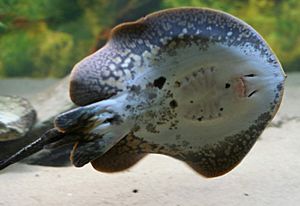Long-tailed river stingray facts for kids
Quick facts for kids Long-tailed river stingray |
|
|---|---|
 |
|
 |
|
| Conservation status | |
| Scientific classification | |
| Kingdom: | |
| Phylum: | |
| Class: | |
| Subclass: | |
| Order: | |
| Family: |
Potamotrygonidae
|
| Genus: |
Plesiotrygon
|
| Species: |
P. iwamae
|
| Binomial name | |
| Plesiotrygon iwamae R. de S. Rosa, Castello & Thorson, 1987
|
|
The long-tailed river stingray (Plesiotrygon iwamae) is a type of freshwater stingray. It is also known as the antenna ray. This animal belongs to the family called Potamotrygonidae.
Scientists first talked about this species in 1987. Hugo P. Castello from the University of São Paulo mentioned it. Later, examples were found in museums that had been misidentified.
Contents
What the Long-tailed River Stingray Looks Like
These stingrays have flat bodies. They have a very long tail. Their eyes are small.
River stingrays can shed their spines. Sometimes, a ray might have two stingers. One is the old one, and the other is a new one growing to replace it.
Most South American river stingrays have colorful patterns. These patterns are on their backs. They often have spots of different sizes. Their background colors can be gray, brown, or black.
Freshwater stingrays can grow to about 18 inches (46 centimeters) wide. Their tails can be as long as 1 foot (30.5 centimeters). The tail is usually about an inch (2.5 centimeters) wide.
Where They Live and What They Eat
The long-tailed river stingray usually lives in fresh water. You can find them in South America, especially in the Amazon. This is different from most fish with cartilage instead of bones. Most of these fish live in salty ocean water.
These stingrays eat many different things. They like worms, crabs and shrimp, and snails and clams. They also eat small fish that live at the bottom, like small catfish.
They are very good at finding food. They can sense electrical and chemical signals. This helps them find prey hidden in mud and sand.
Reproduction and Life Cycle
When a baby ray is born, it is about 3 inches (8 centimeters) wide. Female rays have babies once a year. They usually have two to six young ones at a time.
The mother carries the babies for three months. The baby rays hatch inside the mother's body. They feed on a special milky substance. The mother produces this substance in her uterus. This helps the embryos grow until they are born.
Scientists do not know how long freshwater stingrays live in the wild. But in aquariums, they usually live between 5 and 10 years.
See also
 In Spanish: Raya de cola larga para niños
In Spanish: Raya de cola larga para niños


